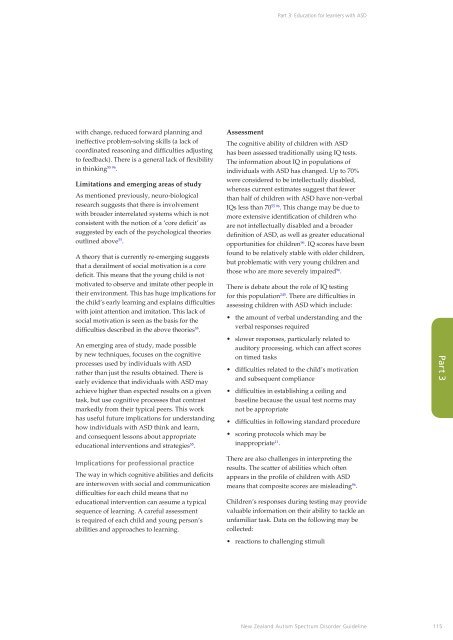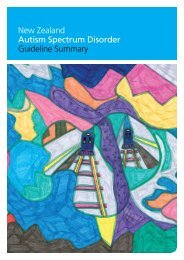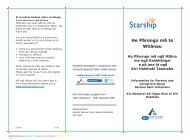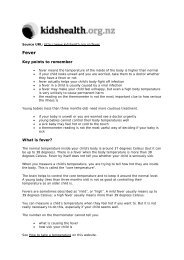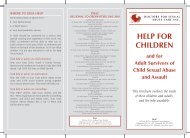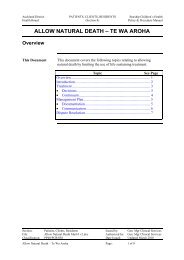New Zealand Autism Spectrum Disorder Guideline - Ministry of Health
New Zealand Autism Spectrum Disorder Guideline - Ministry of Health
New Zealand Autism Spectrum Disorder Guideline - Ministry of Health
You also want an ePaper? Increase the reach of your titles
YUMPU automatically turns print PDFs into web optimized ePapers that Google loves.
Part 3: Education for learners with ASD<br />
with change, reduced forward planning and<br />
ineffective problem-solving skills (a lack <strong>of</strong><br />
coordinated reasoning and difficulties adjusting<br />
to feedback). There is a general lack <strong>of</strong> flexibility<br />
in thinking 55 96 .<br />
Limitations and emerging areas <strong>of</strong> study<br />
As mentioned previously, neuro-biological<br />
research suggests that there is involvement<br />
with broader interrelated systems which is not<br />
consistent with the notion <strong>of</strong> a ‘core deficit’ as<br />
suggested by each <strong>of</strong> the psychological theories<br />
outlined above 55 .<br />
A theory that is currently re-emerging suggests<br />
that a derailment <strong>of</strong> social motivation is a core<br />
deficit. This means that the young child is not<br />
motivated to observe and imitate other people in<br />
their environment. This has huge implications for<br />
the child’s early learning and explains difficulties<br />
with joint attention and imitation. This lack <strong>of</strong><br />
social motivation is seen as the basis for the<br />
difficulties described in the above theories 55 .<br />
An emerging area <strong>of</strong> study, made possible<br />
by new techniques, focuses on the cognitive<br />
processes used by individuals with ASD<br />
rather than just the results obtained. There is<br />
early evidence that individuals with ASD may<br />
achieve higher than expected results on a given<br />
task, but use cognitive processes that contrast<br />
markedly from their typical peers. This work<br />
has useful future implications for understanding<br />
how individuals with ASD think and learn,<br />
and consequent lessons about appropriate<br />
educational interventions and strategies 55 .<br />
Assessment<br />
The cognitive ability <strong>of</strong> children with ASD<br />
has been assessed traditionally using IQ tests.<br />
The information about IQ in populations <strong>of</strong><br />
individuals with ASD has changed. Up to 70%<br />
were considered to be intellectually disabled,<br />
whereas current estimates suggest that fewer<br />
than half <strong>of</strong> children with ASD have non-verbal<br />
IQs less than 70 55 96 . This change may be due to<br />
more extensive identification <strong>of</strong> children who<br />
are not intellectually disabled and a broader<br />
definition <strong>of</strong> ASD, as well as greater educational<br />
opportunities for children 96 . IQ scores have been<br />
found to be relatively stable with older children,<br />
but problematic with very young children and<br />
those who are more severely impaired 96 .<br />
There is debate about the role <strong>of</strong> IQ testing<br />
for this population 245 . There are difficulties in<br />
assessing children with ASD which include:<br />
• the amount <strong>of</strong> verbal understanding and the<br />
verbal responses required<br />
• slower responses, particularly related to<br />
auditory processing, which can affect scores<br />
on timed tasks<br />
• difficulties related to the child’s motivation<br />
and subsequent compliance<br />
• difficulties in establishing a ceiling and<br />
baseline because the usual test norms may<br />
not be appropriate<br />
• difficulties in following standard procedure<br />
• scoring protocols which may be<br />
inappropriate 11 .<br />
Part 3<br />
Implications for pr<strong>of</strong>essional practice<br />
The way in which cognitive abilities and deficits<br />
are interwoven with social and communication<br />
difficulties for each child means that no<br />
educational intervention can assume a typical<br />
sequence <strong>of</strong> learning. A careful assessment<br />
is required <strong>of</strong> each child and young person’s<br />
abilities and approaches to learning.<br />
There are also challenges in interpreting the<br />
results. The scatter <strong>of</strong> abilities which <strong>of</strong>ten<br />
appears in the pr<strong>of</strong>ile <strong>of</strong> children with ASD<br />
means that composite scores are misleading 96 .<br />
Children’s responses during testing may provide<br />
valuable information on their ability to tackle an<br />
unfamiliar task. Data on the following may be<br />
collected:<br />
• reactions to challenging stimuli<br />
<strong>New</strong> <strong>Zealand</strong> <strong>Autism</strong> <strong>Spectrum</strong> <strong>Disorder</strong> <strong>Guideline</strong> 115


